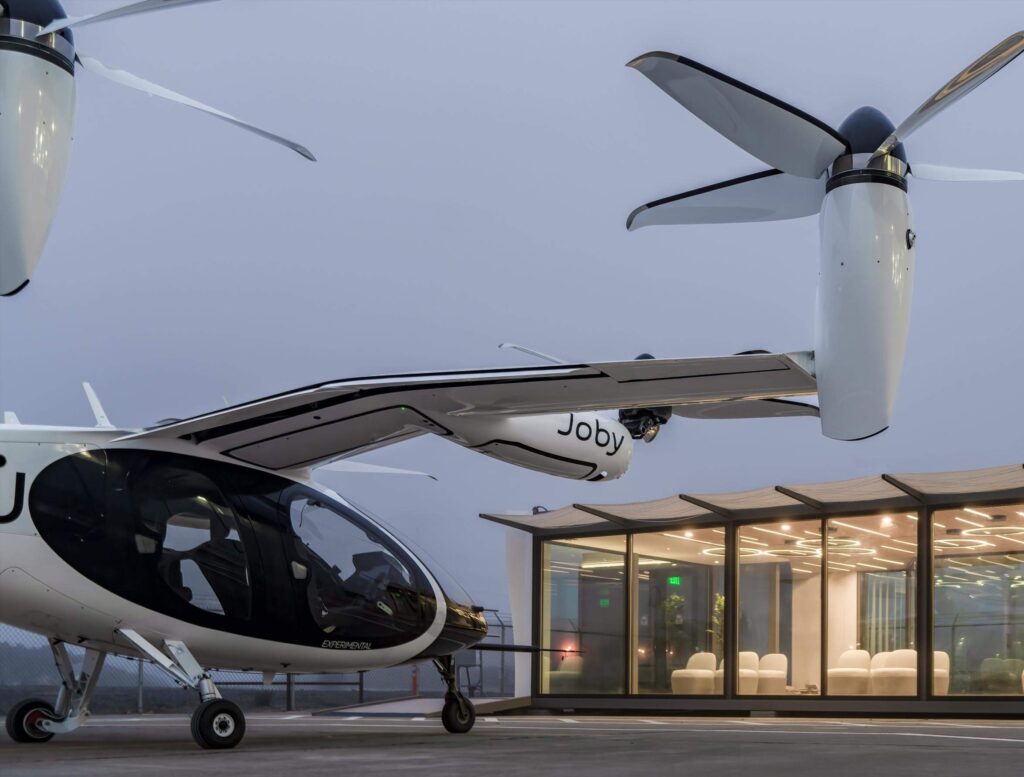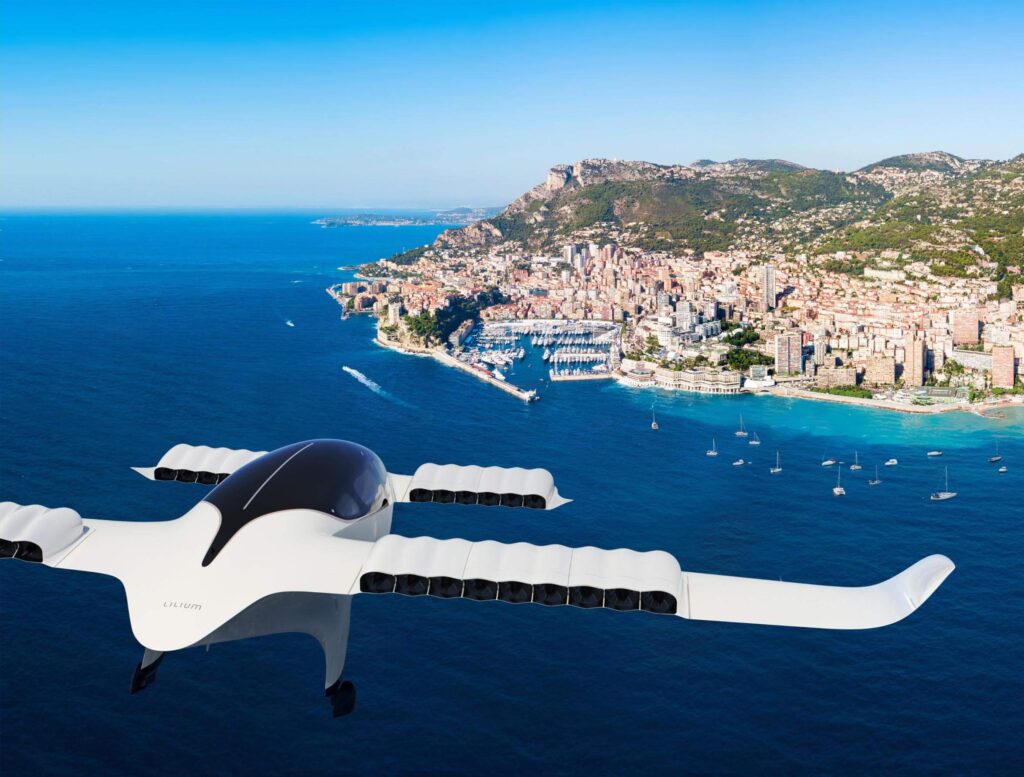Singapore has one. Paris and London do too. At least 10 are planned in Florida, with 20 proposed for Spain. In Miami and Los Angeles, you may soon find vertiports on the roofs of parking decks or high-rise buildings. Worldwide, you’ll find them at major airports.
What is a vertiport? It’s a facility where travelers will board electric air taxis, officially known as eVTOLs: electric-powered vertical-takeoff-and-landing vehicles capable of zero-emission, short-range flights.
Together, vertiports and eVTOLs comprise a new industry: Advanced Air Mobility (AAM), also referred to as Urban Air Mobility (UAM). The lure of AAM? As JoeBen Bevirt, CEO and founder of eVTOL developer Joby Aviation told The Wall Street Journal in a recent video: “Saving a billion people an hour [of travel time] every day.”
Vertiports get their name by combining the word ”vertical” – which describes how the vehicles take off and land – with the word “airport.” Just like airports, vertiports will have security and boarding areas, luggage services, and maintenance facilities, including spots to park and electrically recharge eVTOLs between flights. Vertiports also are being discussed for the rooftops of center-city high-rises, parking decks and hospitals; some of the sites in discussion currently serve helicopters.

Who will vertiports serve?
Unlike airports, which connect distant cities, vertiports will host short-range flights within a city, between a city center and its outlying airport, or between cities located within 240 kilometers (about 150 miles) of each other, on average. In Florida, for example, a vertiport at Orlando’s airport could transport tourists who arrive on commercial airlines to smaller vertiports at each of the area’s theme parks. (No such plan for Orlando has been announced, but it’s a likely scenario.) In cities like Paris with well-developed public transport, vertiports could ferry passengers between airports and train depots or bus terminals.
The relatively short range of eVTOL flights is necessary because eVTOLs are battery powered, which limits the distance they can fly. The batteries also are heavy, so just lifting an eVTOL to its low cruising altitude takes a big chunk of the vehicle’s stored power. Typical cruising altitudes for eVTOLs are expected to occur at a height of 1,000 to 3,000 feet (300-900 meters).
Having to carry their own power supply also limits passenger counts. Some eVTOLs will carry only a pilot and one passenger. Others accommodate a pilot and three passengers, plus luggage. Someday, when eVTOL developers hope to offer automated flights, all four seats can be assigned to passengers.
While battery power creates limitations, it also gives eVTOLs two valuable advantages: they don’t emit greenhouse gases when they fly, and they operate almost silently. Those advantages mean that vertiports probably won’t generate much public opposition, as new airports and heliports do.
With help from NASA, Joby is targeting a noise level of 65 decibels for their vehicles – about the volume of a normal conversation. A fleet of sky taxis, Joby’s Bevirt told The Wall Street Journal, “means regular flights in and out of built-up areas, which only works if the aircraft is really quiet.”
Organizers don’t expect air taxi rides to be expensive, either. Like traditional taxis, prices will vary based on location, length of the ride, time of day and demand. But most proponents are projecting rates similar to those of an Uber Black, which typically costs 17 to 35 in both US dollars and euros. A NASA study estimated that rides will cost between US$2.25 and $11 per mile per passenger. Three major eVTOL developers – Archer, Eve and Lilium – have projected prices between $2 and $4 per passenger mile.

When will vertiports begin service?
One of the biggest questions about vertiports is when they might begin serving commercial passengers. The answer will depend on when the electric air taxis win certification from governmental safety agencies.
Although the Vertical Flight Society reports that more than 300 companies are developing eVTOL designs, no eVTOL has yet been certified for commercial use by the US Federal Aviation Administration (FAA) or the European Union Aviation Safety Agency (EASA). Until certification occurs, eVTOLs are limited to demonstration flights – no passengers, just spectators. Regulators also need to develop procedures for integrating eVTOLs into existing air traffic control systems.
eVTOL certifications are most likely to begin in 2024 or 2025. A spokesman for Germany-based Volocopter recently told WebInTravel.com that it is “locked for” EASA certification in 2024. Germany’s Lilium plans to open its first vertiport near Orlando by 2025. US-based Joby Aviation has received the first of five certifications required by the FAA, and is well on its way to receiving the second. UK-based Vertical Aerospace is targeting certification by 2025.
With the earliest eVTOL certification at least two years away, neither the FAA nor EASA has issued final rules for building vertiports, though both have provided enough guidance to develop prototype vertiports. Guidance to date includes recommendations on minimum clearances, lighting, ground markings and coexistence with existing commercial airport runways.
Where can I see a vertiport and eVTOLs in action?
Despite the open question of eVTOL certification, organizers of the 2024 Summer Olympic Games in Paris are moving full speed ahead with plans for air taxis to add another exciting attraction to the inherent lure of the Games.
At Cergy-Pointoise Airport, 35 kilometers (about 22 miles) north of Paris, Choose Paris Region has organized the RE.Invent Air Mobility initiative, a series of trials intended to help define the outlines of the AAM industry. The organization’s short-term goal: to help the AAM industry and the city of Paris make a huge splash with eVTOLS at the 2024 Olympics.
Ideally, Paris officials hope to shuttle athletes and spectators among the Games’ 40 venues and its villages for media and athletes aboard eVTOLs. If certification doesn’t happen in time, though, they still plan for eVTOLs to have a high profile at the event. Bloomberg even reported plans to land eVTOLs on a barge in the Seine River during the Games.
“We want to try and see how it works as it is commercialized,” Edward Arkwright, deputy chief executive of Groupe ADP, told The Times of London in June 2022. “What is your reaction [as a consumer]? Do you carry bags or not? How much are you ready to pay? I can’t answer these questions without a real face, a real test. And the real face would be during this famous summer of 2024.”
Commercial eVTOL interests are only too happy to collaborate. What better place to show off their emerging industry than in front of the 10 million in-person spectators and 4 billion television viewers expected to attend or tune in for the Games? Not surprisingly, many of the major eVTOL developers – including Volcopter, Pipistrel, Airbus UAM, Lilium, Vertical Aerospace and Joby Aviation – are participating in trials at Cergy-Pointoise. About 20 more companies are working on vertiports and infrastructure, airspace integration, and operations.
The Cergy-Pointoise vertiport was developed for Groupe ADP by UK-based Skyports, which also operates test vertiports in London, Boston and Singapore.
“I am 100% confident there’ll be a rich number of eVTOL demonstrations over the Paris skies during the Games,” Damian Kysely, Skyports head of infrastructure for Europe, the Middle East and Africa, told evtolinsights.com in July 2022. “Whether there will be passengers on board is another matter. The objective is to provide commercial services. It all depends on how many eVTOLs have gained full certification by then. What I’ve seen and heard in discussions, everything will be done to make commercial flights happen. We have two years left. A lot can happen in that time.”
Learn more about advanced development methods for eVTOLs and vertiports

